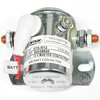Glen Robinson
Filing Flight Plan
- Joined
- Jan 24, 2023
- Messages
- 4
- Display Name
Display name:
FBN6
I purchased and installed a B&C S701-1 battery contactor on my firewall. I'm leery of wiring it the way B&G suggests. The contactor has a jumper wire that runs from the battery post to the positive coil terminal. The negative side terminal is to be connected to a wire that runs to a switch, then to ground. The only protection I see, is that the very thin jumper wire will probably burn out, if there is a short. Because of the location, I wouldn't be able to diagnose the problem in flight (or do anything about it). Out of all the electrical equipment I have installed, this is the only component that doesn't have a fuse, or breaker protection. I have two ways I could possibly wire the battery contactor, to give me the overvoltage protection I would like. I did contact B&C, but I wasn't happy with their advice View attachment 114462 View attachment 114463 View attachment 114465 . I am new member, so hopefully I can upload some diagrams. Does anyone see any problems with the way I want to wire the battery contactor?
Glen


Thanks,
Glen
Glen

Thanks,
Glen


